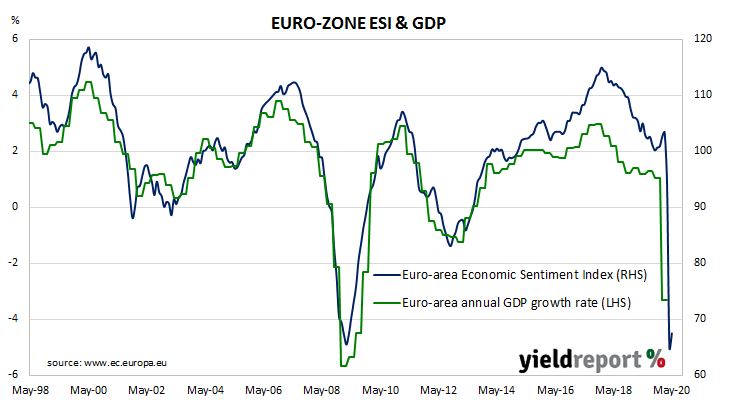Summary: Eurozone composite sentiment index improves slightly; manufacturers remain pessimistic about demand; not all major economies’ indices improve; implies GDP smaller contraction.
The European Commission’s Economic Sentiment Indicator (ESI) is a composite index comprised of five differently-weighted sectoral confidence indicators. It is heavily weighted towards confidence surveys from the business sector; the consumer confidence sub-index only accounts for 20% of the ESI. However, it has a good relationship with euro-area GDP, although not as a leading indicator.
The ESI recorded a reading of 67.5 in May, below the market’s expected figure of 72.5 but up a little from April’s revised reading of 64.9. The average reading since 1985 has been just under 98.
 Overall sentiment in the euro-zone improved as three of the five confidence sub-indices showed gains. The Industry, Consumer and Retail sub-indices increased while the Services and Construction sub-indices deteriorated. On a geographical basis, the ESI rose in Germany and Spain but slipped in France.
Overall sentiment in the euro-zone improved as three of the five confidence sub-indices showed gains. The Industry, Consumer and Retail sub-indices increased while the Services and Construction sub-indices deteriorated. On a geographical basis, the ESI rose in Germany and Spain but slipped in France.
“The improvement in industry confidence was led by improved production expectations,” said ANZ economist Kishti Sen. However, he noted “manufacturers remain pessimistic about demand…”
German and French bond yields either remained stable or finished lower, despite the improved figures and new plans by the European Commission for a €750 billion recovery fund. By the end of the day, the German 10-year bund yield remained unchanged at -0.42% while the French 10-year OAT yield had lost 4bps to -0.06%.

